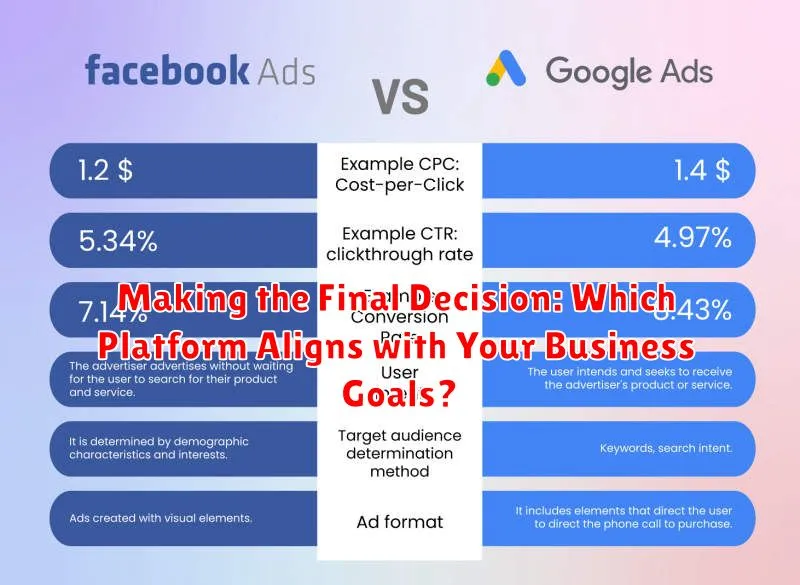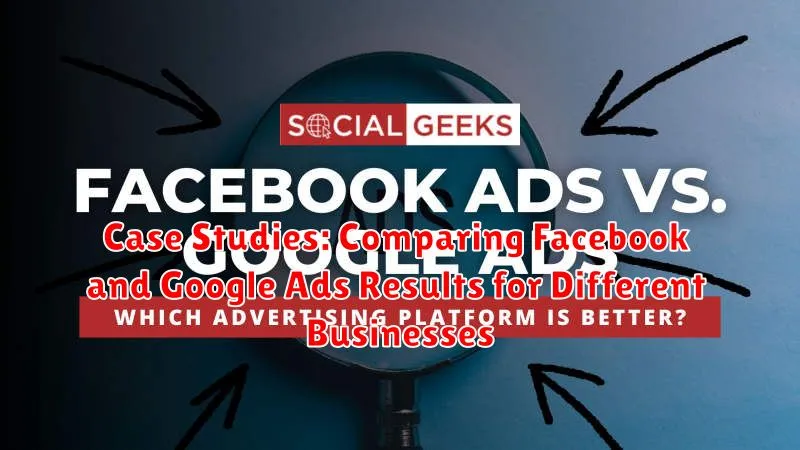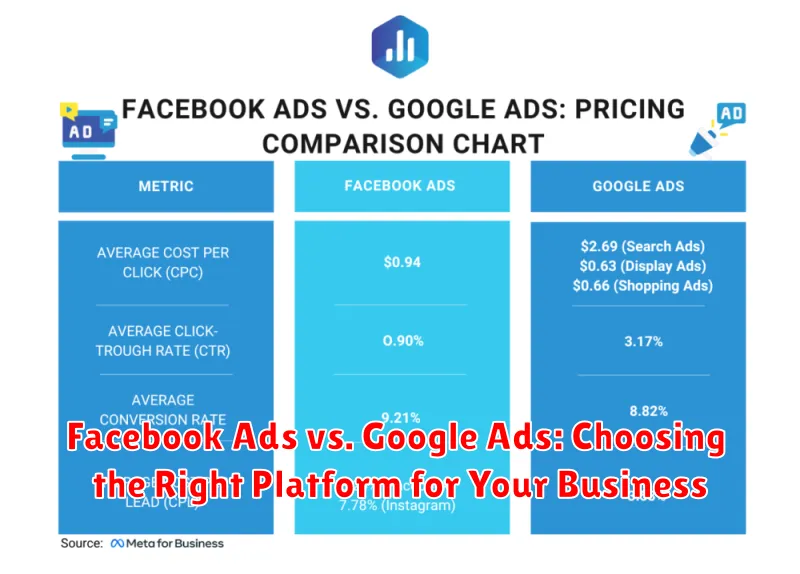Choosing between Facebook Ads and Google Ads can be a crucial decision for any business looking to expand its reach and drive conversions. This comprehensive guide will delve into the nuances of each platform, comparing their strengths and weaknesses to help you determine the most effective advertising strategy for your specific business objectives. Understanding the core differences between Facebook Ads, which focuses on social media marketing and audience targeting, and Google Ads, renowned for its search engine marketing and keyword targeting, is paramount to maximizing your return on investment (ROI).
Whether you’re aiming to build brand awareness, generate leads, drive website traffic, or boost sales, selecting the right platform is essential. We’ll explore the various advertising formats available on both Facebook Ads and Google Ads, discussing their targeting capabilities, cost considerations, and measurement metrics. By the end of this guide, you’ll be equipped with the knowledge necessary to make an informed decision and choose the platform best suited to achieve your marketing goals, whether that’s through the power of social media advertising with Facebook Ads or the precision of search engine advertising with Google Ads.
Understanding the Core Differences Between Facebook and Google Ads
Facebook and Google Ads represent two distinct approaches to online advertising. Facebook Ads operates on a “push” marketing model, proactively displaying ads to users based on their demographics, interests, and online behavior. This allows businesses to reach potential customers even if they aren’t actively searching for a product or service.
Google Ads, conversely, follows a “pull” marketing approach. Ads are primarily displayed to users actively searching for specific keywords on Google’s search engine or browsing websites within Google’s Display Network. This caters to users already expressing a need or interest, providing highly targeted advertising opportunities.
Understanding this fundamental difference in approach is crucial for choosing the platform best aligned with your specific marketing goals.
Reaching Your Target Audience: Facebook’s Focus on Demographics and Interests vs. Google’s Keyword Targeting
Facebook and Google Ads offer distinct approaches to targeting. Facebook excels in targeting based on demographics, interests, and behaviors. You can target users based on age, location, education, job title, and even their expressed interests like specific hobbies or brands they follow. This detailed targeting allows for reaching niche audiences and tailoring ad copy to resonate with specific groups.
Google Ads, conversely, primarily uses keyword targeting. Ads are displayed to users actively searching for specific terms related to your products or services. This intent-based targeting is highly effective in capturing users already in the buying cycle. Google Ads also offers location targeting and other options like device type, allowing for further refinement, though less granular than Facebook’s demographic targeting.
Choosing the right platform depends on your business objectives. Are you looking to build brand awareness among a specific demographic, even if they aren’t actively searching? Facebook might be a better fit. If you want to reach users actively looking for what you offer, Google Ads might be more effective.
Campaign Objectives and Ad Formats: What Works Best on Each Platform
Campaign objectives differ significantly between the two platforms. Facebook Ads excel at brand awareness, engagement, and driving traffic to specific content. Consider Facebook for campaigns focused on lead generation, app installs, and increasing event attendance. Google Ads, on the other hand, is highly effective for driving direct sales and conversions. Its strength lies in capturing users actively searching for products or services.
Ad formats also play a crucial role in platform selection. Facebook offers a diverse range of visually engaging formats, including image and video ads, carousel ads, and Stories. These formats are ideal for showcasing products and telling brand stories. Google Ads primarily focuses on text-based search ads, displayed alongside search results. Google also offers Shopping ads, showcasing product images and prices directly within search, and Display ads, which appear on websites within Google’s network.
| Platform | Objective Strengths | Ad Format Strengths |
|---|---|---|
| Brand Awareness, Engagement, Lead Generation | Image/Video Ads, Carousel Ads, Stories | |
| Direct Sales, Conversions, Product Search | Search Ads, Shopping Ads, Display Ads |
Budgeting and Bidding Strategies for Facebook and Google Ads
Budgeting for both platforms offers flexibility. You can set daily or lifetime budgets, allowing control over ad spending. Facebook emphasizes minimum daily budgets at the ad set level, while Google Ads allows more granular campaign-level budget control.
Bidding strategies differ significantly. Facebook primarily uses automated bidding, focusing on objectives like conversions or link clicks. You can choose manual bidding for more direct control over cost-per-click (CPC). Google Ads offers a wider range of bidding strategies, including automated options like Maximize Clicks, Target CPA, and Maximize Conversions, alongside manual bidding for CPC, CPM (cost-per-thousand impressions), and CPV (cost-per-view).
Understanding the nuances of each platform’s budgeting and bidding systems is crucial for optimizing campaign performance and achieving your desired ROI.
Measuring Success: Key Metrics and Reporting Tools
Measuring the success of your advertising campaigns is crucial for optimizing performance and maximizing your return on investment. Both Facebook and Google Ads provide robust reporting tools and a range of metrics to track progress.
Key metrics for Facebook Ads often include reach, engagement (likes, comments, shares), website clicks, and conversions. Facebook’s Ads Manager provides in-depth data on campaign performance, audience demographics, and ad creative effectiveness.
Google Ads emphasizes metrics such as click-through rate (CTR), conversion rate, cost per click (CPC), and return on ad spend (ROAS). Google Ads’ reporting dashboard offers insights into keyword performance, search queries, and geographic targeting.
By understanding and analyzing these key metrics within each platform’s reporting interface, you can identify areas for improvement, refine your targeting, and ultimately drive better results from your advertising efforts.
Integrating Facebook and Google Ads for a Comprehensive Strategy
While Facebook and Google Ads can be used independently, integrating them creates a powerful synergistic approach. This strategy leverages the strengths of both platforms to maximize reach and impact.
A common integration strategy uses Facebook Ads to build brand awareness and generate initial interest. By targeting specific demographics and interests, you can introduce your product or service to potential customers. Then, retargeting campaigns on Google Ads can capture those users who showed initial interest but didn’t convert. By displaying ads related to their previous engagement, you can effectively re-engage them as they search for related keywords on Google.
Another approach involves using Google Ads to target high-intent keywords and capture users actively searching for solutions. Subsequently, Facebook Ads can nurture these leads by providing valuable content and building stronger relationships. This multi-touch approach guides potential customers through the sales funnel, from initial awareness to final conversion.
Key to a successful integration is consistent messaging and branding across both platforms. This unified approach strengthens brand recall and builds trust with your target audience.
Making the Final Decision: Which Platform Aligns with Your Business Goals?

Choosing between Facebook and Google Ads ultimately depends on your specific business objectives and target audience. There is no one-size-fits-all answer. Carefully consider the following factors to make the best decision for your business:
1. Business Objectives:
Are you focused on building brand awareness, driving immediate sales, or generating leads? Facebook Ads excel at brand building and engagement, while Google Ads is highly effective for driving conversions and capturing users actively searching for your products or services.
2. Target Audience:
Where does your target audience spend their time online? If your audience is highly active on Facebook, leveraging its detailed targeting options might be the best approach. If your audience is actively searching for solutions online, Google Ads can connect you with them at the moment of need.
3. Budget and Resources:
Consider your budget and the resources you have available to manage your campaigns. Both platforms require ongoing optimization and monitoring. Experimentation is key to finding the optimal strategy for your business.
Case Studies: Comparing Facebook and Google Ads Results for Different Businesses

Examining real-world examples illustrates the strengths of each platform. Case Study 1 features an e-commerce store selling handmade jewelry. Facebook Ads, targeting users interested in fashion and crafting, yielded a higher return on ad spend (ROAS) due to strong visual engagement and direct product showcasing. Conversely, Case Study 2 showcases a local plumbing service. Google Ads, triggered by keywords like “emergency plumber” and “leaky faucet,” delivered superior results by capturing immediate customer needs. This direct response approach proved more effective than Facebook’s broader targeting for this service-based business.
Case Study 3 focuses on a SaaS company offering project management software. A combined strategy proved most beneficial, using Google Ads to target specific keywords related to project management tools, while Facebook Ads nurtured leads with informative content and retargeting campaigns. This demonstrates the potential synergy of integrating both platforms.

